27.11.2018
NASA Hears MarCO CubeSats Loud and Clear from Mars

MarCO-B, one of the experimental Mars Cube One CubeSats, took this image of Mars from about 4,700 miles (6,000 kilometers) away during its flyby of the Red Planet on Nov. 26, 2018. This image was taken at about 12:10 p.m. PST (3:10 p.m. EST) while MarCO-B was flying away from the planet after InSight landed. Image Credit: NASA/JPL-Caltech.
NASA's MarCO mission was built to see whether two experimental, briefcase-sized spacecraft could survive the trip to deep space, and the two CubeSats proved more than able. After cruising along behind NASA's InSight for seven months, they successfully relayed data back down to Earth from the lander during its descent to the Martian surface on Monday, Nov. 26.
Nicknamed "EVE" and "WALL-E" after the stars of the 2008 Pixar film, MarCO-A and MarCO-B used experimental radios and antennas, providing an alternate way for engineers to monitor the landing. The CubeSats provided information to InSight's landing team in just 8 minutes — the time it took for radio signals to travel from Mars to Earth. That was much faster than waiting on NASA's Mars orbiters, which weren't positioned to be able to observe the entire event and send data back to Earth immediately.
"WALL-E and EVE performed just as we expected them to," said MarCO chief engineer Andy Klesh of NASA's Jet Propulsion Laboratory in Pasadena, California, which built the CubeSats. "They were an excellent test of how CubeSats can serve as 'tag-alongs' on future missions, giving engineers up-to-the-minute feedback during a landing."
Landing on Mars is exceptionally difficult: Before InSight, only about 40 percent of all attempts by various nations had succeeded. Even if a spacecraft doesn't survive landing, having a "black box" — or a pair of them, as with MarCO — to record the event can help engineers design better landing technology.
Neither of the MarCO CubeSats carry science instruments, but that didn't stop the team from testing whether future CubeSats could perform useful science at Mars. As MarCO-A flew by, it conducted some impromptu radio science, transmitting signals through the edge of Mars' atmosphere. Interference from the Martian atmosphere changes the signal when received on Earth, allowing scientists to determine how much atmosphere is present and, to some degree, what it's made of.
"CubeSats have incredible potential to carry cameras and science instruments out to deep space," said John Baker, JPL's program manager for small spacecraft. "They'll never replace the more capable spacecraft NASA is best known for developing. But they're low-cost ride-alongs that can allow us to explore in new ways."
As a bonus, some consumer-grade cameras aboard MarCO provided "drive-by" images as the CubeSats sailed past Mars. MarCO-B was programmed to turn so that it could image the planet in a sequence of shots as it approached Mars (before launch, MarCO-A's cameras were found to be either non-functioning or too blurry to use).
After the landing, MarCO-B turned backward to take a farewell shot of the Red Planet. It also attempted to snap some photos of Mars' moons, Phobos and Deimos.
"WALL-E sent some great postcards from Mars!" said Cody Colley of JPL, MarCO's mission manager, who led the work to program each CubeSat to take images. "It's been exciting to see the view from almost 1,000 miles (1,600 kilometers) above the surface."
With the mission's objectives reached, the MarCO team will spend the next couple of weeks collecting additional data on each CubeSat. Of interest will be how much fuel is left in each CubeSat and detailed analyses of how their relay capability performed.
There's also sure to be more celebrating among the team.
"MarCO is mostly made up of early-career engineers and, for many, MarCO is their first experience out of college on a NASA mission," said Joel Krajewski of JPL, MarCO's project manager. "We are proud of their accomplishment. It's given them valuable experience on every facet of building, testing and operating a spacecraft in deep space."
+++
Technology Demonstration
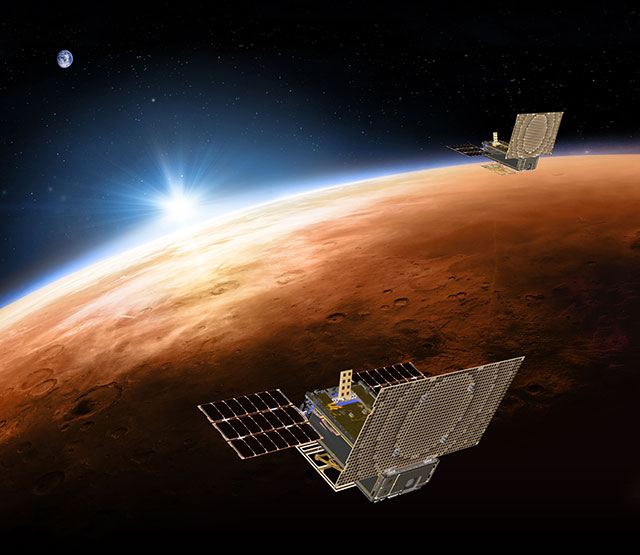
Illustration of MarCo-A and MarCo-B flying over Mars
A technology demonstration called Mars Cube One (MarCO) is the first deep space use of the miniature, modular “CubeSat” spacecraft design. The pair of briefcase-sized spacecraft -- MarCO-A and B -- launched on the same rocket as InSight. They have already completed a number of risky deep space navigation and communication experiments. During InSight’s landing, they will attempt to relay the spacecraft’s data as it descends to the Martian surface.

The first image captured by one of NASA’s Mars Cube One (MarCO) CubeSats. The image, which shows both the CubeSat’s unfolded high-gain antenna at right and the Earth and its Moon in the center, was taken by MarCO-B on May 9, 2018.
Achievements to date
MarCO has already achieved a number of impressive firsts for CubeSats:
- They’ve successfully tested several experimental technologies, including their radios, high-gain antennas and propulsion systems
- They became the first CubeSats to fly to deep space, providing images of Earth and its moon along the way
- They performed the first trajectory correction maneuvers by CubeSats, each steering toward Mars
An Experiment at Mars
MarCO-A and MarCO-B, also nicknamed EVE and Wall-E, have flown separately toward Mars. Should they reach the planet, they would pass it at about 2,175 miles (3,500 kilometers) away just as InSight is landing. It will take only one of them to receive transmissions from InSight and relay them back to provide status information to Earth about the InSight lander’s descent and touchdown.
The success of the InSight mission does not depend on MarCO’s performance (see “Listening for InSight” for more detail). Should the MarCO CubeSats make it all the way to Mars, each has the capability to relay a substantive amount of data almost immediately, transmitting status information on a speed-of-light trip to Earth lasting 8 minutes and 7 seconds across about 90.7 million miles (146 million kilometers) between the two planets.
The reason for flying two identical MarCO spacecraft is redundancy in case either one does not operate as planned.

JPL engineer Joel Steinkraus works with one of the MarCO CubeSats during an outdoor test of its solar arrays.
Going Where No CubeSats Have Gone Before
CubeSats are a class of spacecraft based on a standardized small size and modular use of off-the-shelf technologies. Many have been made by university students, and hundreds have been launched into Earth orbit using extra payload mass available on launches of larger spacecraft.
But MarCO is the first attempt to send CubeSats to another planet. By verifying that the technologies for interplanetary missions are feasible and can be developed on a short timeline, this test mission could lead to many other SmallSat applications for exploring our solar system. Some could provide similar support functions as “carry your own” relay providers. Others could have primary scientific research functions of their own, such as radio transmissions through planetary atmospheres, imaging with small cameras, observations with other miniaturized instruments, or in-place measurements of space environments.
The MarCO Spacecraft: Small but Mighty
The basic CubeSat unit is a box roughly 4 inches (10 centimeters) square. Larger CubeSats are multiples of that unit. MarCO’s design is a six-unit CubeSat. Each of the two spacecraft has a stowed size of about 14.4 inches (36.6 centimeters) by 9.5 inches (24.3 centimeters) by 4.6 inches (11.8 centimeters).

Illustration of one of the twin MarCO spacecraft with some key components labeled. Front cover is left out to show some internal components. Antennas and solar arrays are in deployed configuration. Download image
During the flight to Mars, the MarCO twins each deployed a high-gain X-band antenna that is a flat “reflect array” panel engineered to direct radio waves the way a parabolic dish antenna does. This should allow MarCO to transmit data to Earth from as far away as Mars without needing much power. Two smaller X-band antennas on each spacecraft -- one low-gain and one medium-gain -- work without needing to be deployed. These allowed transmissions earlier in the flight and also receive radioed commands from Earth.
The other deployed antenna is for the MarCO ultra-high frequency (UHF) radio receiver. InSight will be transmitting in UHF during its descent through the Martian atmosphere and from the surface of Mars. Both of the deployed antennas on each MarCO will be in fixed positions after deployment, with the high-gain antenna and UHF antenna facing different directions 90-degrees apart. The MarCOs have also tested new technology using a softball-sized radio, called Iris. This radio provides both UHF (receive-only) and X-band (receive-and-transmit) functions capable of immediately relaying information received over UHF, at 8 kilobits per second. A color wide-field engineering camera on each MarCO was used to confirm high-gain antenna deployment. The wide-field camera has a 138-degree diagonal field of view. MarCO-B also carries a color narrow-field camera with a 6.8-degree diagonal field of view pointed in the direction of the UHF antenna (the opposite direction from the high-gain antenna). (MarCO-A’s narrow-field camera was found to be inoperable prior to launch.) Both kinds of cameras can produce images 752 x 480 pixels in resolution.
Each MarCO’s attitude-control system combines a star tracker, Sun sensors, gyroscopes and three-axis reaction wheels for monitoring and adjusting orientation. Accelerating a reaction wheel rotates the spacecraft in the opposite direction from the direction the wheel is spinning.
MarCO’s propulsion system uses compressed R236FA gas, a common propellant in fire extinguishers. Each MarCO has eight thrusters that release this cold-gas propellant in different directions from a single, shared tank. The thrusters operate for trajectory adjustments and for desaturating the reaction wheels. MarCO is pioneering CubeSat use of propellant for desaturating attitude-control reaction wheels; Earth-orbiting CubeSats typically control attitude with electromagnet devices that “push” against Earth’s magnetic field, an option not available to MarCO in deep space.
Mission controllers have used the “cruise” period of flying from Earth to Mars not only to complete communication and navigation technology demonstration objectives, but also to check out each MarCO’s temperatures, power levels and other onboard subsystems. Each MarCO carries heaters, multiple temperature sensors, thermal blanketing and two radiators for thermal control.
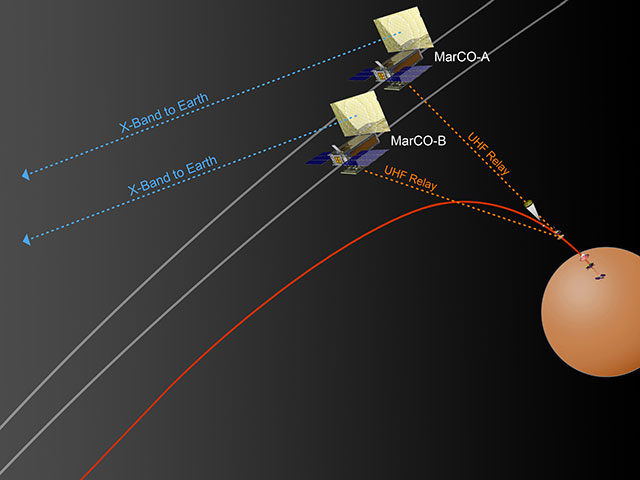
If all goes well, on Nov. 26, 2018, MarCO-A and MarCO-B will be flying past Mars during the critical minutes when InSight enters the Martian atmosphere, descends toward the surface and touches down. Each MarCO will maintain an orientation with the UHF antenna pointed down toward InSight as it lands on Mars, and the high-gain X-band antenna pointed back toward Earth. In this orientation, the solar panels will not be fully facing the Sun, so MarCO will be operating primarily on battery power. InSight will be transmitting its status information at 8 kilobits per second over UHF. Each MarCO will attempt to receive that data stream, format it and relay it Earthward in near-real-time to NASA’s Deep Space Network.
Since MarCO adds formatting information, as well as a small amount of spacecraft information, to the datastream, the delay is expected to increase as more data are sent from InSight. The delay, however, is not expected to be more than a few minutes. Earth will be oriented so that the information relayed via MarCO will go to the Madrid, Spain, station of the Deep Space Network, from which it will be routed to the InSight mission operations team.
NASA’s Jet Propulsion Laboratory in Pasadena, California, which manages both InSight and MarCO for NASA, built the two MarCO spacecraft in JPL’s CubeSat assembly clean room. At JPL, Joel Krajewski is MarCO’s project manager and Andrew Klesh is MarCO’s project engineer.
Technology suppliers for MarCO include: Blue Canyon Technologies in Boulder, Colorado, for the attitude-control system; VACCO Industries in South El Monte, California, for the cold-gas thrusters; AstroDev in Ann Arbor, Michigan, for electronics; MMA Design LLC, also in Boulder, for solar arrays; and Tyvak Nano-Satellite Systems Inc., a Terran Orbital Company in San Luis Obispo, California, for the CubeSat dispenser system.
Quelle: NASA
----
Update: 1.12.2018
.
Mars New Home 'a Large Sandbox'
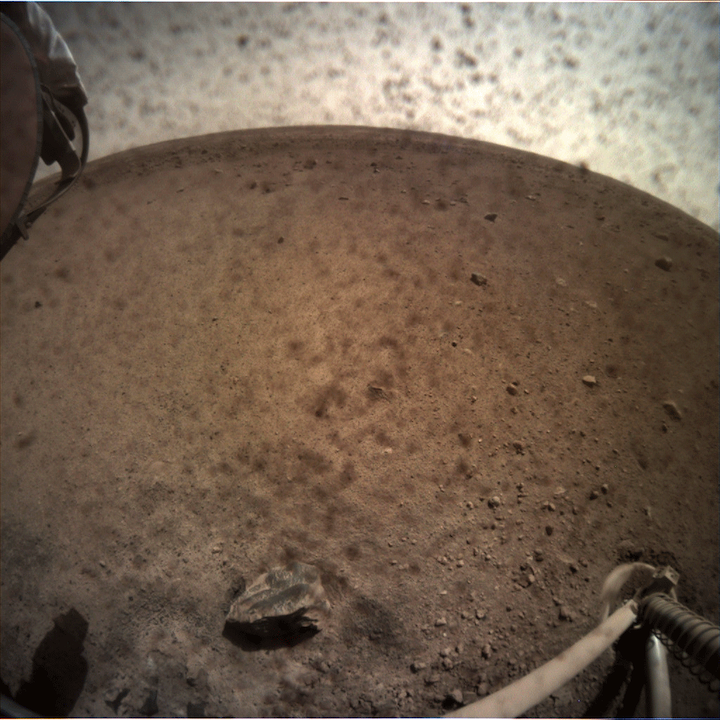
NASA’s InSight spacecraft flipped open the lens cover on its Instrument Context Camera (ICC) on Nov. 30, 2018, and captured this view of Mars. Located below the deck of the InSight lander, the ICC has a fisheye view, creating a curved horizon. Image Credit: NASA/JPL-Caltech.
With InSight safely on the surface of Mars, the mission team at NASA's Jet Propulsion Laboratory in Pasadena, California, is busy learning more about the spacecraft's landing site. They knew when InSight landed on Nov. 26 that the spacecraft had touched down on target, a lava plain named Elysium Planitia. Now they've determined that the vehicle sits slightly tilted (about 4 degrees) in a shallow dust- and sand-filled impact crater known as a "hollow." InSight has been engineered to operate on a surface with an inclination up to 15 degrees.
"The science team had been hoping to land in a sandy area with few rocks since we chose the landing site, so we couldn't be happier," said InSight project manager Tom Hoffman of JPL. "There are no landing pads or runways on Mars, so coming down in an area that is basically a large sandbox without any large rocks should make instrument deployment easier and provide a great place for our mole to start burrowing."
Rockiness and slope grade factor into landing safety and are also important in determining whether InSight can succeed in its mission after landing. Rocks and slopes could affect InSight's ability to place its heat-flow probe — also known as "the mole," or HP3 — and ultra-sensitive seismometer, known as SEIS, on the surface of Mars.
Touching down on an overly steep slope in the wrong direction could also have jeopardized the spacecraft's ability to get adequate power output from its two solar arrays, while landing beside a large rock could have prevented InSight from being able to open one of those arrays. In fact, both arrays fully deployed shortly after landing.
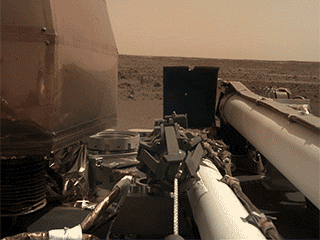
As visible in this two-frame set of images, NASA’s InSight spacecraft unlatched its robotic arm on Nov. 27, 2018, the day after it landed on Mars. Image Credit: NASA/JPL-Caltech
The InSight science team's preliminary assessment of the photographs taken so far of the landing area suggests the area in the immediate vicinity of the lander is populated by only a few rocks. Higher-resolution images are expected to begin arriving over the coming days, after InSight releases the clear-plastic dust covers that kept the optics of the spacecraft's two cameras safe during landing.
"We are looking forward to higher-definition pictures to confirm this preliminary assessment," said JPL's Bruce Banerdt, principal investigator of InSight. "If these few images — with resolution-reducing dust covers on — are accurate, it bodes well for both instrument deployment and the mole penetration of our subsurface heat-flow experiment."
Once sites on the Martian surface have been carefully selected for the two main instruments, the team will unstow and begin initial testing of the mechanical arm that will place them there.
Data downlinked from the lander also indicate that during its first full day on Mars, the solar-powered InSight spacecraft generated more electrical power than any previous vehicle on the surface of Mars.
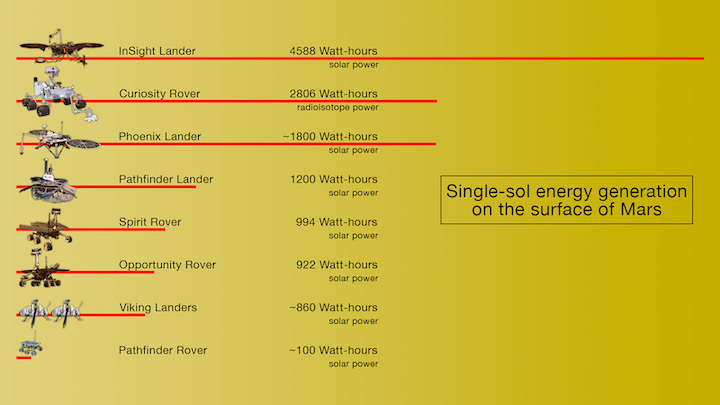
This graphic compares the amount of energy ever generated in a single sol (Martian day) by NASA rovers and landers on the Red Planet. Image Credit: NASA/JPL-Caltech
"It is great to get our first 'off-world record' on our very first full day on Mars," said Hoffman. "But even better than the achievement of generating more electricity than any mission before us is what it represents for performing our upcoming engineering tasks. The 4,588 watt-hours we produced during sol 1 means we currently have more than enough juice to perform these tasks and move forward with our science mission."
Launched from Vandenberg Air Force Base in California May 5, InSight will operate on the surface for one Martian year, plus 40 Martian days, or sols — the equivalent of nearly two Earth years. InSight will study the deep interior of Mars to learn how all celestial bodies with rocky surfaces, including Earth and the Moon, formed.
JPL manages InSight for NASA's Science Mission Directorate. InSight is part of NASA's Discovery Program, managed by the agency's Marshall Space Flight Center in Huntsville, Alabama.
A number of European partners, including France's Centre National d'Études Spatiales (CNES) and the German Aerospace Center (DLR), are supporting the InSight mission. CNES, and the Institut de Physique du Globe de Paris (IPGP), provided the SEIS instrument, with significant contributions from the Max Planck Institute for Solar System Research (MPS) in Germany, the Swiss Institute of Technology (ETH) in Switzerland, Imperial College and Oxford University in the United Kingdom, and JPL. DLR provided the HP3 instrument, with significant contributions from the Space Research Center (CBK) of the Polish Academy of Sciences and Astronika in Poland. Spain's Centro de Astrobiología (CAB) supplied the wind sensors.
+++
Away from Mars, With Sunburst
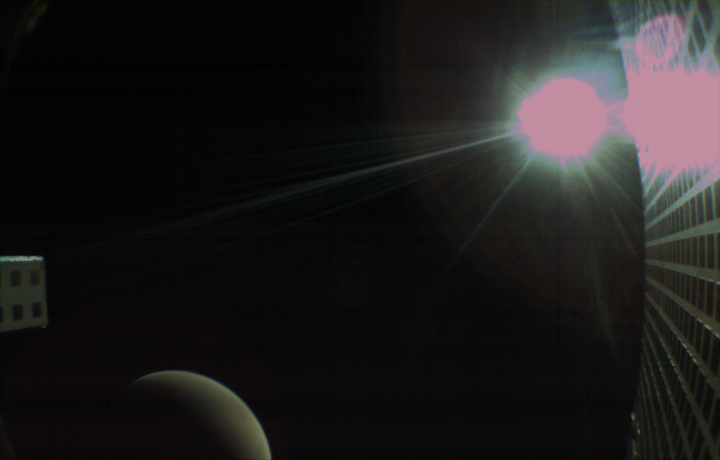
November 30, 2018
MarCO-B, one of the experimental Mars Cube One (MarCO) CubeSats, took this image of Mars from about 10,900 miles (17,500 kilometers) away just after NASA’s InSight spacecraft landed on Mars on Nov. 26, 2018. MarCO-B flew by Mars with its twin, MarCO-A, to serve as communications relays for InSight as it touched down on the Red Planet around noon PST (3 p.m. EST). This image was taken at 1 p.m. PST (4 p.m. EST).
Mars’ south pole is facing the viewer in this image. MarCO-B’s antenna reflector is on the right and antenna feed (white rectangle with gold square) is on the left. The Sun at upper right overexposed part of the image. This image was taken after PIA22833 and shortly before PIA22834.
The MarCO and InSight projects are managed for NASA's Science Mission Directorate, Washington, by JPL, a division of Caltech, Pasadena.
+++
Mars, Before InSight's Landing
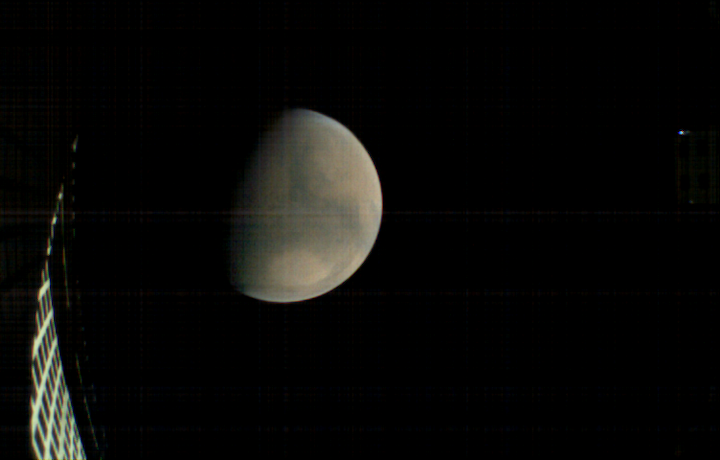
November 30, 2018
MarCO-B, one of the experimental Mars Cube One (MarCO) CubeSats, took this image of Mars from about 11,300 miles (18,200 kilometers) away shortly before NASA’s InSight spacecraft landed on Mars on Nov. 26, 2018. MarCO-B flew by Mars with its twin, MarCO-A, to serve as communications relays for InSight spacecraft as it touched down around noon PST (3 p.m. EST). This image was taken at 10:35 a.m. PST (1:35 p.m. EST).
Mars’ north pole is at the top. A lighter-toned circular feature known as Hellas Basin is visible in the southern hemisphere. MarCO-B’s antenna reflector can be seen at left. The blue dot on the right is a glint of sunlight off the antenna feed (not visible in the picture).
The MarCO and InSight projects are managed for NASA's Science Mission Directorate, Washington, by JPL, a division of Caltech, Pasadena.
Quelle: NASA
----
Update: 4.12.2018
.
NASA's InSight Lander on Mars Just Set a Solar Power Record!
NASA's InSight lander, which touched down on Mars Nov. 26 and successfully extended its large solar arrays hours later, is already setting records.
During its full first day on the Red Planet, the solar-powered lander generated more electrical power in one day than any previous Mars vehicle has, mission team members said.
"It is great to get our first 'off-world record' on our very first full day on Mars," Tom Hoffman, InSight project manager at NASA's Jet Propulsion Laboratory (JPL) in California, said in a statement.
"But even better than the achievement of generating more electricity than any mission before us is what it represents for performing our upcoming engineering tasks," Hoffman added. "The 4,588 watt-hours we produced during sol 1 means we currently have more than enough juice to perform these tasks and move forward with our science mission."
The 4,588 watt-hours InSight generated on its first sol, or Martian day, from solar power is well over the 2,806 watt-hours generated in a day by NASA's Curiosity rover, which runs on a nuclear system called a radioisotope thermoelectric generator. Coming in third was the solar-powered Phoenix lander, which generated around 1,800 watt-hours in a day, according to NASA officials.
After sending back its first photo of the landing site and extending its two solar arrays, each of which is about 7 feet in diameter (2.2 meters), InSight got to work photographing its environment and unlatching its robotic arm, which it will eventually use to deploy seismometers and a heat probe to learn about Mars' interior.
And mission team members are busy inspecting the images they've received so far to learn more about InSight's landing site, a lava plain called Elysium Planitia. They've found that the spacecraft is tilted by about 4 degrees, according to the statement, in a shallow impact crater filled with dust and sand. (This is no big deal; the lander can operate at up to a 15-degree tilt.) A steep slope could have hurt the spacecraft's ability to get enough power from its solar arrays, and landing near rocks could have kept the spacecraft from easily opening both arrays, the researchers said.
"The science team had been hoping to land in a sandy area with few rocks since we chose the landing site, so we couldn't be happier," Hoffman said in the statement. "There are no landing pads or runways on Mars, so coming down in an area that is basically a large sandbox without any large rocks should make instrument deployment easier and provide a great place for our mole to start burrowing."
So far, the team thinks the immediate area has few rocks, but higher-resolution images coming later on will give a more conclusive view of the surroundings. The team will use those views to plan out exactly how the spacecraft will place its instruments with its mechanical arm.
"We are looking forward to higher-definition pictures to confirm this preliminary assessment," InSight principal investigator Bruce Banerdt, also at JPL, said in the statement. "If these few images — with resolution-reducing dust covers on — are accurate, it bodes well for both instrument deployment and the mole penetration of our subsurface heat-flow experiment." (According to NASA, the spacecraft got its first view of Mars with a lens cover off Nov. 30.)
The $850 million InSight mission is scheduled to run for one Mars year, or nearly two Earth years. The data gathered by the lander will help mission team members map out the Red Planet's interior structure in unprecedented detail, NASA officials have said. This information should, in turn, reveal key insights about the formation of rocky planets in general.
Quelle: SC
---
Update: 6.12.2018
.
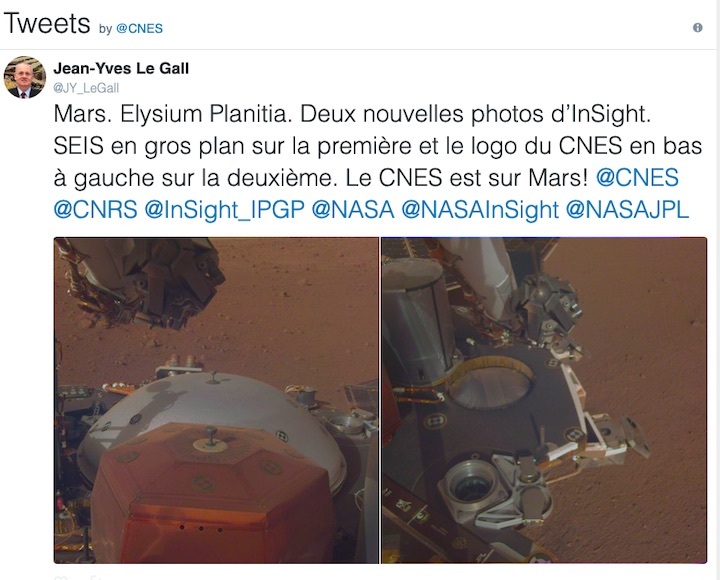
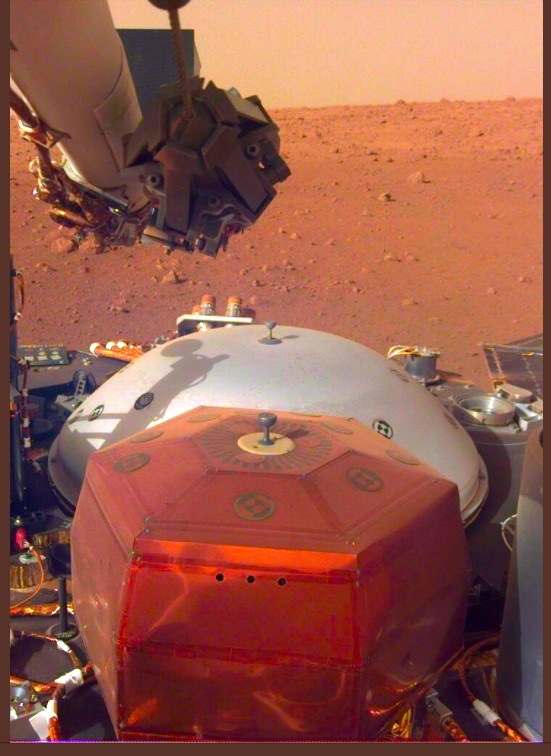
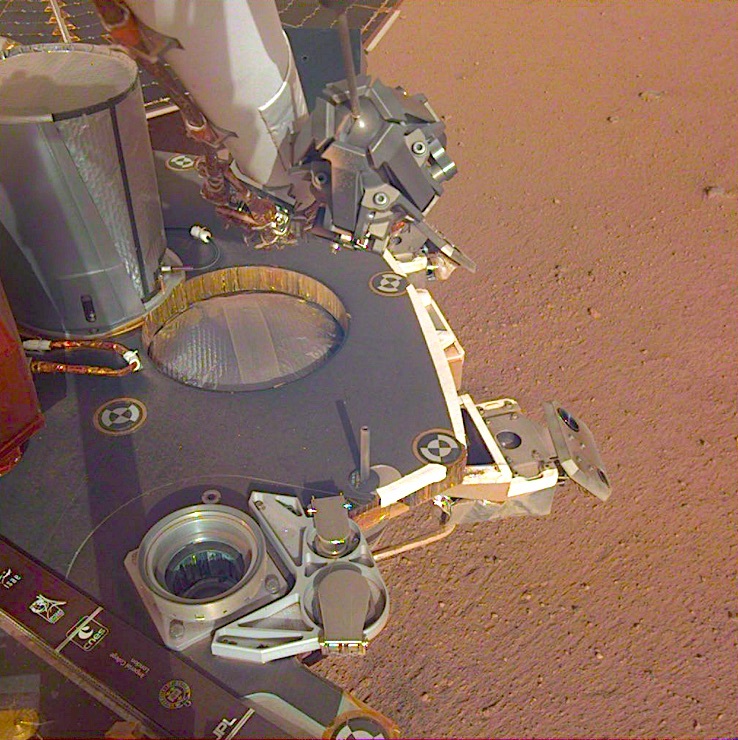
Quelle: CNES, NASA
+++
Raise your hand if you’re in this new photo from #Mars ! These two tiny chips contain the names of more than 2.4 million people who signed up to fly with me. We’re ON MARS, you guys. You’re all honorary Martians!
! These two tiny chips contain the names of more than 2.4 million people who signed up to fly with me. We’re ON MARS, you guys. You’re all honorary Martians!
Heben Sie Ihre Hand, wenn Sie in diesem neuen Foto von #Mars! Diese beiden winzigen Chips enthalten die Namen von mehr als 2,4 Millionen Menschen, die sich angemeldet haben, um mit mir zu fliegen. Wir sind ON MARS, ihr Jungs. Eure alle ehrenamtlichen Marzianer!
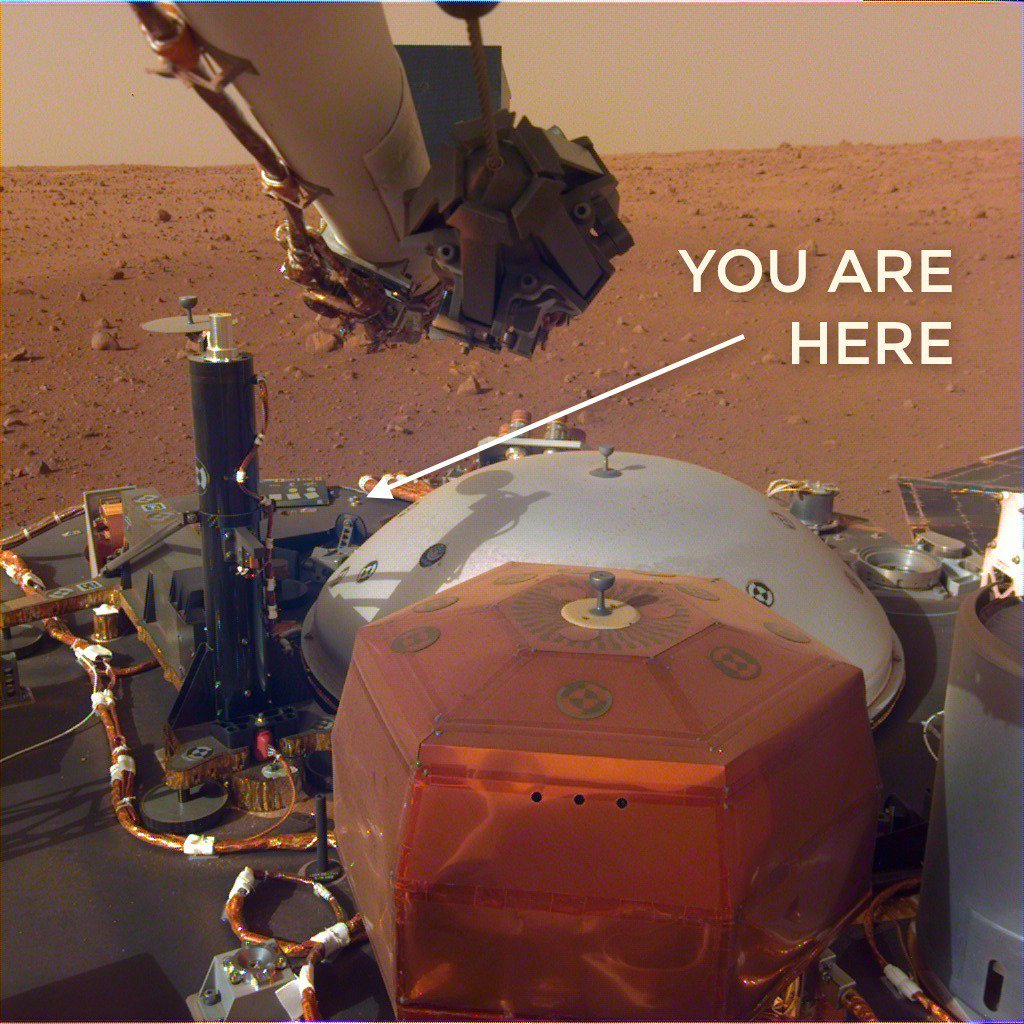
Raise your hand if you’re in this new photo from #Mars:
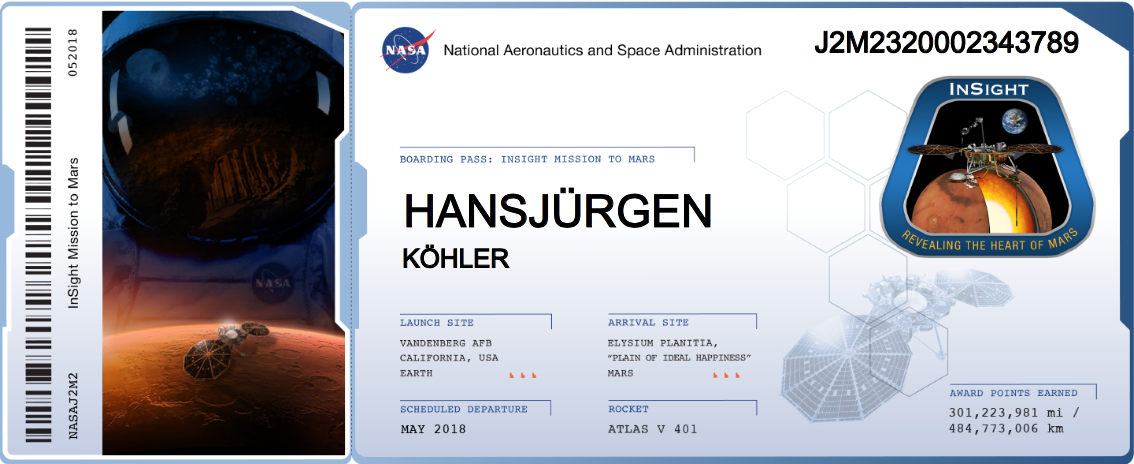
Quelle: NASA
----
Update: 7.12.2018
.
NASA's Mars InSight Flexes Its Arm
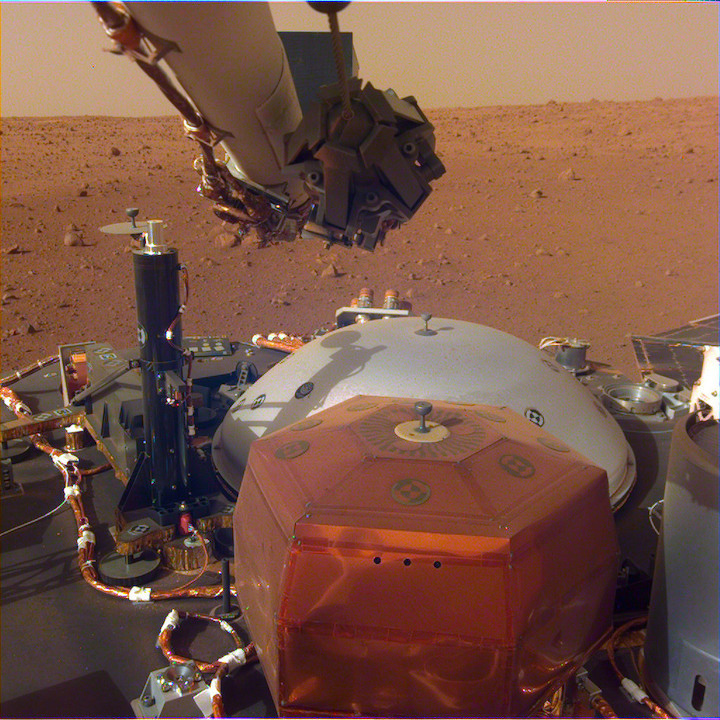
his image from InSight's robotic-arm mounted Instrument Deployment Camera shows the instruments on the spacecraft's deck, with the Martian surface of Elysium Planitia in the background. Image Credit: NASA/JPL-Caltech. Full image and Caption
New images from NASA's Mars InSight lander show its robotic arm is ready to do some lifting.
But first, the arm will use its Instrument Deployment Camera, located on its elbow, to take photos of the terrain in front of the lander. These images will help mission team members determine where to set InSight's seismometer and heat flow probe — the only instruments ever to be robotically placed on the surface of another planet.
"Today we can see the first glimpses of our workspace," said Bruce Banerdt, the mission's principal investigator at NASA's Jet Propulsion Laboratory in Pasadena, California. "By early next week, we'll be imaging it in finer detail and creating a full mosaic."
"We had a protective cover on the Instrument Context Camera, but somehow dust still managed to get onto the lens," said Tom Hoffman of JPL, InSight's project manager. "While this is unfortunate, it will not affect the role of the camera, which is to take images of the area in front of the lander where our instruments will eventually be placed."
Placement is critical, and the team is proceeding with caution. Two to three months could go by before the instruments have been situated and calibrated.
Over the past week and a half, mission engineers have been testing those instruments and spacecraft systems, ensuring they're in working order. A couple instruments are even recording data: a drop in air pressure, possibly caused by a passing dust devil, was detected by the pressure sensor. This, along with a magnetometer and a set of wind and temperature sensors, are part of a package called the Auxiliary Payload Sensor Subsystem, which will collect meteorological data.
More images from InSight's arm were scheduled to come down this past weekend. However, imaging was momentarily interrupted, resuming the following day. During the first few weeks in its new home, InSight has been instructed to be extra careful, so anything unexpected will trigger what's called a fault. Considered routine, it causes the spacecraft to stop what it is doing and ask for help from operators on the ground.
"We did extensive testing on Earth. But we know that everything is a little different for the lander on Mars, so faults are not unusual," Hoffman said. "They can delay operations, but we're not in a rush. We want to be sure that each operation that we perform on Mars is safe, so we set our safety monitors to be fairly sensitive initially."
Spacecraft engineers had already factored extra time into their estimates for instrument deployment to account for likely delays caused by faults. The mission's primary mission is scheduled for two Earth years, or one Mars year — plenty of time to gather data from the Red Planet's surface.
+++
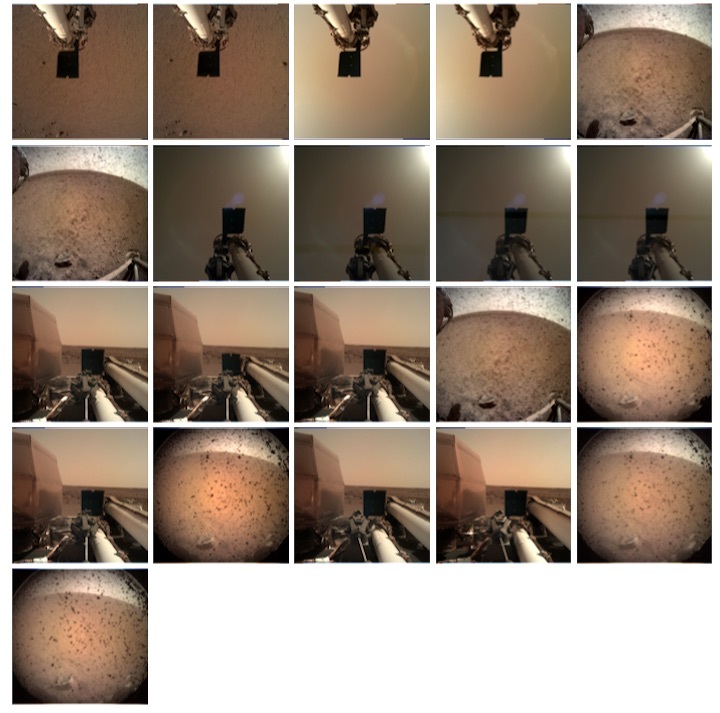
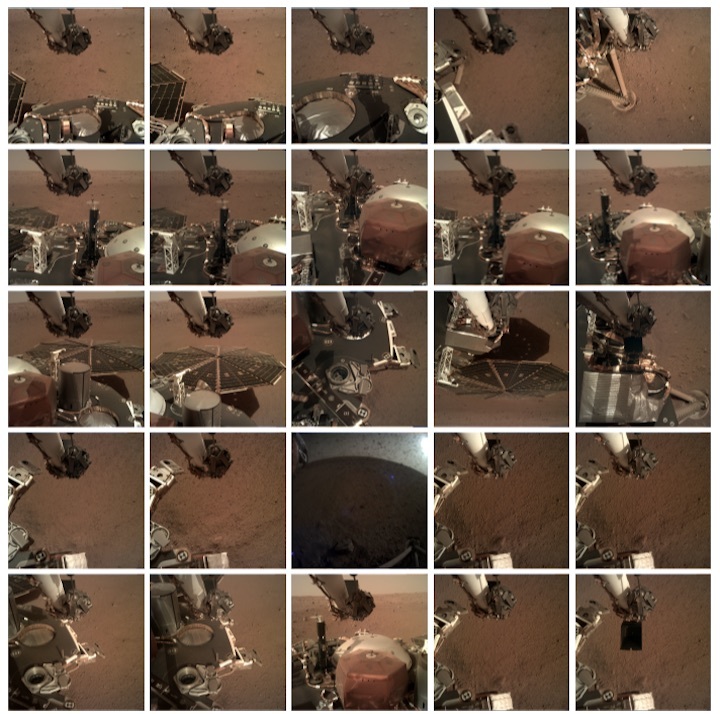
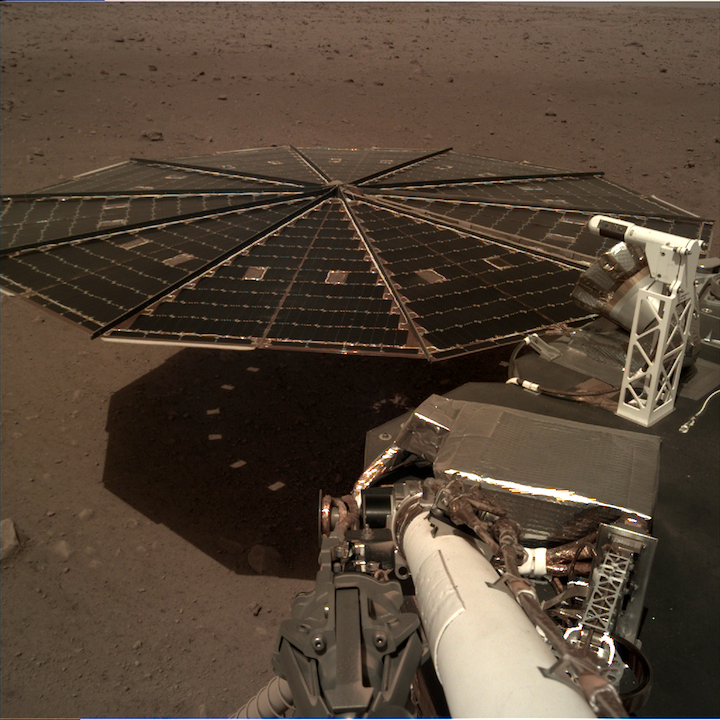
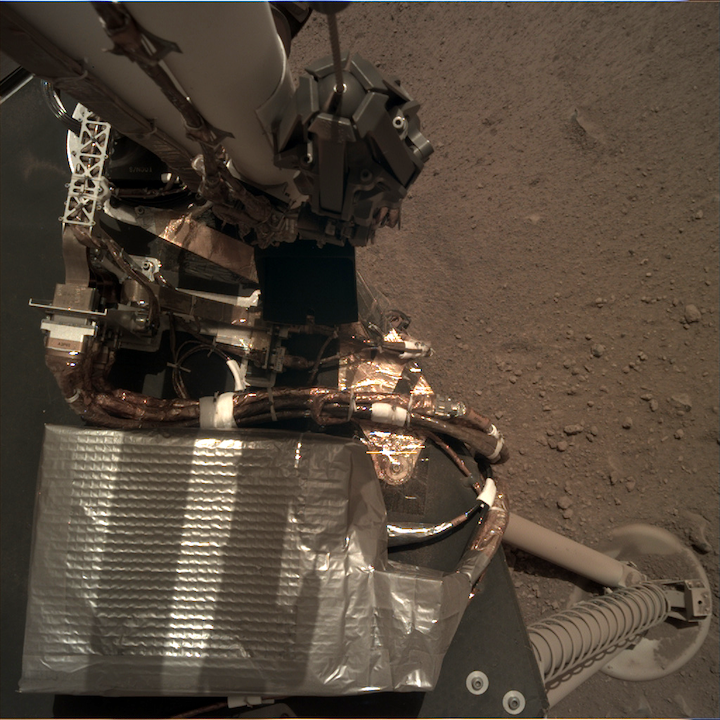
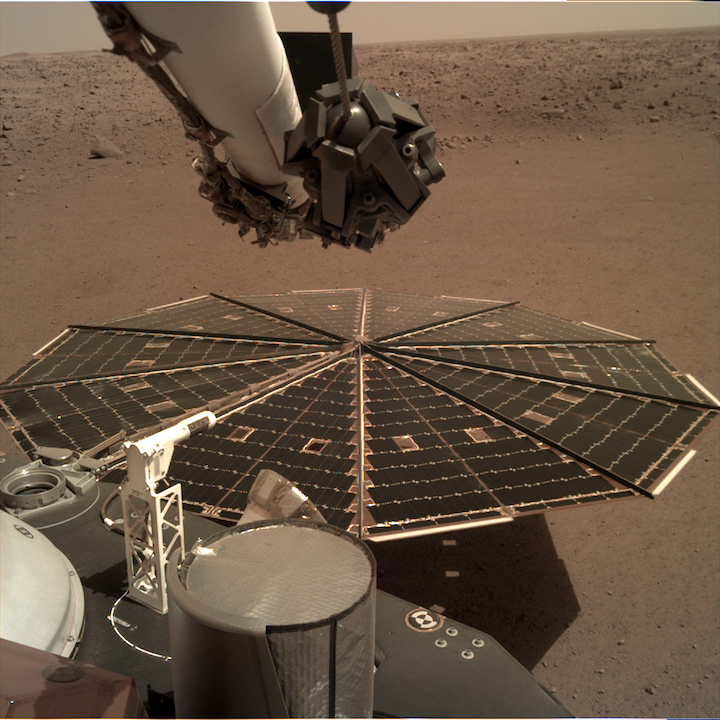
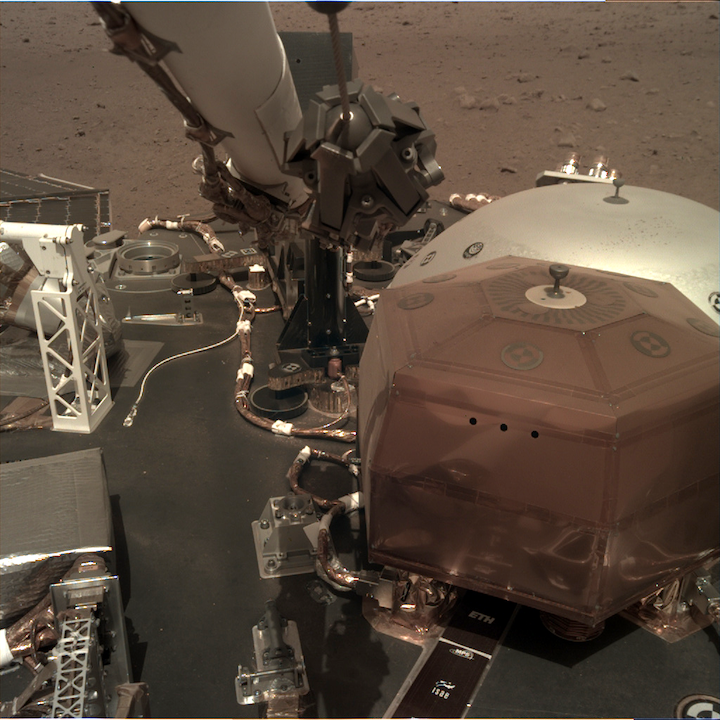
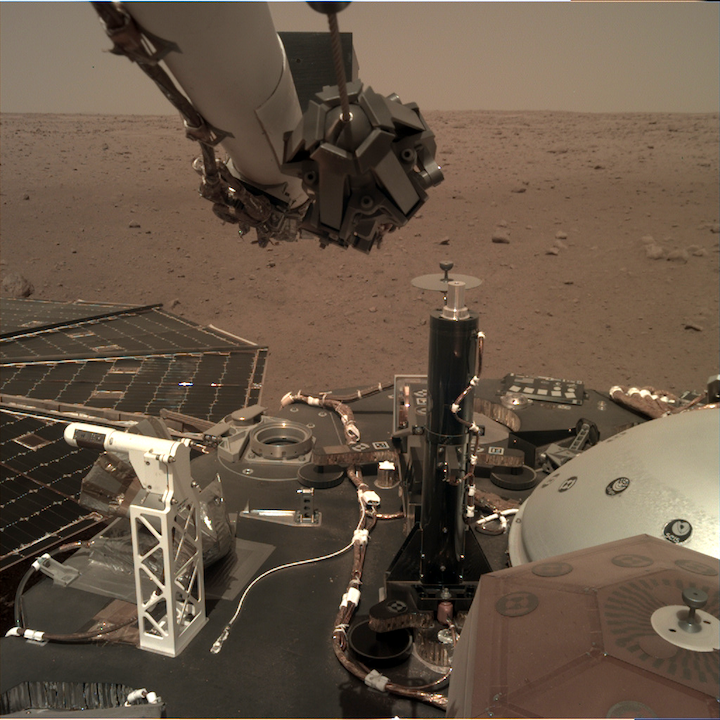

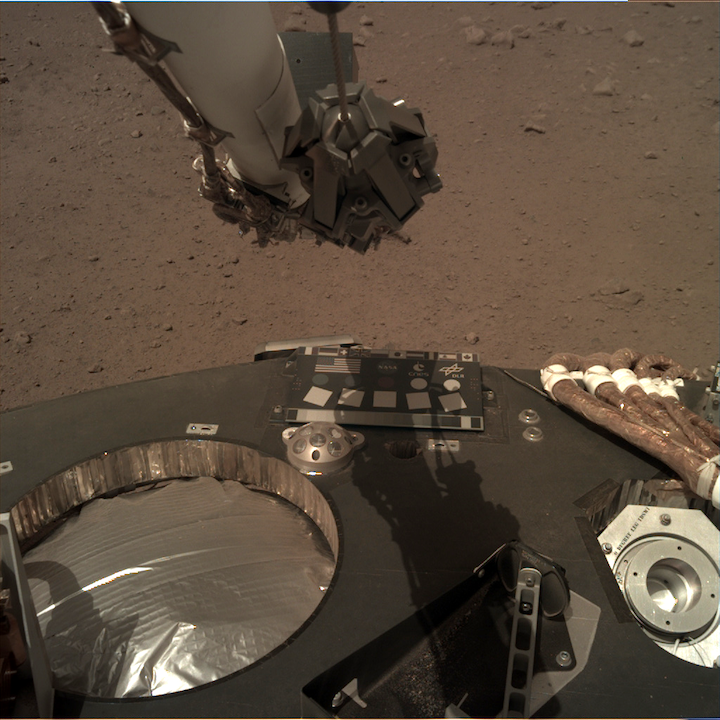
Quelle: NASA
